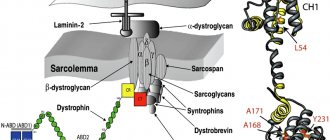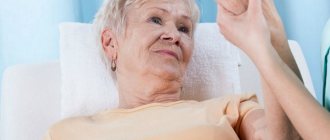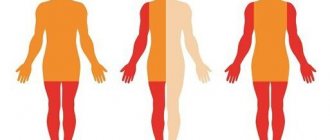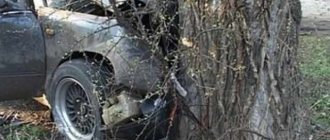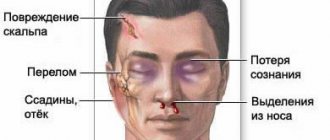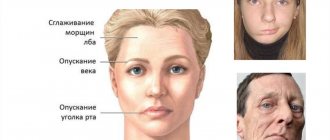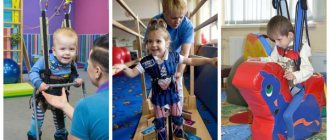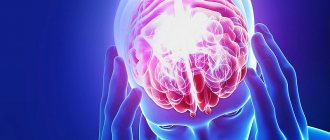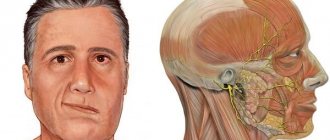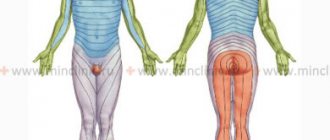Duchenne-Erb palsy is a disease in which patients experience paralysis of the arm due to disruption of the innervation of the upper trunk of the brachial plexus. This disorder can develop in adults as a result of an infectious process or intoxication, as well as in newborns due to birth trauma.
The neurology clinic of the Yusupov Hospital has the necessary equipment for diagnosing pathology, as well as experienced specialists using modern methods of therapy. The activities offered by rehabilitation doctors at the Yusupov Hospital to patients after treatment for Duchenne paresis help them return to an active life and eliminate residual effects.
Duchenne-Erb paresis: causes of the disease
Before answering a question from a patient diagnosed with Erb's palsy of the right arm about how to treat the disease, specialists conduct an examination to determine the causes of the pathology. Thus, in newborns, the development of Duchenne palsy is preceded by a birth injury, as a result of which tension or rupture of the trunks of the brachial nerve plexus occurs. Risk factors for the development of paresis in newborns are: high weight of the baby, narrow pelvis in the mother, long labor, which requires the use of auxiliary methods.
The causes of Erb's paresis in adults are mechanical damage. Thus, rupture of nerve fibers in the shoulder often occurs in car accidents when a person is wearing a seat belt. The main mechanical damage leading to Duchenne-Erb's paresis is:
- shoulder bruise;
- sharp traction on the hand;
- sprains;
- neck injuries.
Erb's palsy can also develop due to the action of other factors on the body, one of which is toxic damage. Neurologists at the Yusupov Hospital, when a patient presents with signs of this disease, conduct a comprehensive diagnosis to identify the causes.
Diagnosis of Duchenne-Erb's palsy
Duchenne-Erb's palsy requires accurate diagnosis to determine treatment tactics. Diagnosis in Israel is carried out using radiography, electromyography, and cerebrospinal fluid examination. Modern computerized equipment used by Israeli specialists makes it possible to quickly identify the disease and select effective treatment. Prospective research practiced at the Top Ichilov Clinic is a success among many medical centers around the world. The Top Ichilov Clinic provides services for not only comprehensive, but also specialized diagnostics. To carry out the latter, doctors with narrow specializations are involved, this allows us to consider the problem much more deeply. Methods for diagnosing Duchenne-Erb's palsy used at the Top Ichilov Clinic:
- electromyography
- electroradiography
- positron emission tomography + computed tomography
- Magnetic resonance imaging (without penetration)
- transcranial magnetic stimulation
- electroencephalography
- cerebrospinal fluid puncture
- ultrasonography.
- 5
- 4
- 3
- 2
- 1
(18 votes, average: 3.8 out of 5)
Symptoms of Duchenne-Erb paresis
Duchenne's paresis is characterized by dysfunction of several muscles: the brachialis, deltoid and biceps. Symptoms for this disease depend on the degree of damage to the nerve fibers, as well as the stage of the pathology.
The development of the pathological process occurs in several stages:
- The acute stage is characterized by the appearance of difficulties when bending the elbow, as well as a decrease in hand function. The duration of this stage is up to 3 days;
- recovery stage. With optimal treatment methods, swelling of the affected area decreases, and blood circulation gradually normalizes. However, complete restoration of lost functions may require long-term rehabilitation;
- stage of residual effects. Timely treatment allows you to avoid serous consequences, such as muscle hypertrophy and separation of the scapula from the spine. These processes occur at the stage of residual effects; treatment of the pathology is ineffective during this period.
Signs of the pathological process in children appear in the first days of life. Constant crying and restlessness of a child should be a serious signal indicating problems in the body. Thus, with Duchenne paralysis, children experience severe pain, which causes anxiety in the newborn. The following symptoms also indicate the development of a pathological process in children:
- decreased muscle tone;
- hand clenched into a fist;
- the arm is extended at the elbow;
- pale skin;
- weak breathing.
Only specialists can identify Duchenne's paresis and make a diagnosis, guided by research results. In the Yusupov Hospital, when examining a patient, European equipment is used, which is characterized by high accuracy of results and the ability to visualize details of the body.
Treatment of Erb-Duchenne palsy
The question immediately arises whether this can be cured and how. The answer to this is the method of treating paralysis developed by Academician Gritsenko (correction of segmental innervation). It is based on two laws in the field of medicine, discovered and patented by him. The method allows very precise and targeted work (with your hands) with a vertebra to remove its subluxation (i.e., realign it), restore the correct position of the vertebrae and secure all this with special therapeutic exercises according to Gritsenko. As a result, the innervation of a particular organ improves, self-healing and restoration of the functions of this organ occurs. In the future, with short breaks, several more sessions follow (from 3 to 5), which help the muscles change their motor pattern for the better. In combination with therapeutic exercises, good dynamics are observed in the treatment of paralysis.
Objective studies such as “electromyography” show how much the speed of signal transmission along nerve fibers increases. Muscle strength is restored, posture improves, and long-standing headaches disappear.
Duchenne's paresis: treatment and rehabilitation at the Yusupov Hospital
A patient who has been diagnosed with Erb's paresis receives high-quality treatment and rehabilitation when visiting the Yusupov Hospital. After the diagnosis is made, step-by-step treatment begins, in accordance with the individual program. Drug therapy is one of the important components of a comprehensive program, as it helps relieve pain and swelling during the acute stage. With Duchenne-Erb paresis, the limb is immobilized.
Physiotherapeutic procedures performed by specialists at the Yusupov Hospital Rehabilitation Center help maintain muscle tone. Thus, massages, physical therapy, and electrical muscle stimulation are indicated for patients with Duchenne's paresis. Conservative treatment methods are effective for partial damage to nerve fibers. If a tissue rupture occurs, the patient is indicated for surgical repair of the damage.
Duchenne-Erb paresis is a serious pathology, in the treatment of which specialists at the Yusupov Hospital Neurology Clinic use only proven methods. A special area of activity of the medical institution is the rehabilitation of patients in the rehabilitation center under the guidance of experienced instructors, trainers and other specialists.
To obtain specialist advice, you must make an appointment by phone: Yusupov Hospital.
Causes
Many patients whose brachial plexus was damaged during childbirth know about this problem from their parents, but still do not know how to restore the strength of the arm muscles and relieve certain pains.
Most traumatologists recognize that paralysis occurs as a result of osteoarticular injuries (“Traumatology and Orthopedics”, edited by G.S. Yumashev). What is this mysterious damage? Some of them may be real fractures, but in most cases, these are banal subluxations of the cervical vertebrae.
As is known from anatomy, the vertebrae are normal, i.e. standing in the correct physiological position (lordosis or kyphosis), not in subluxation, their bodies form rounded channels in cross-section on both sides. In each canal, a neurovascular bundle or radicular nerve passes without interference, which, merging with its own kind, forms the brachial plexus.
Now let's imagine what will happen to this canal if the vertebrae move towards each other at a slight angle, i.e. subluxation or stasis will occur. The canal becomes curved, its cross-section is no longer round, but slit-like and begins to compress the nerve roots. Thus, negative conditions are created for the functioning of the brachial plexus, up to complete disruption or even so-called peripheral paralysis.
Duchenne-Erb palsy: shoulder injury during childbirth
Journalist Valery Panyushkin put the whole country on edge with the stories of Misha Permyakov and Styopa Yashchenko, who were diagnosed with Duchenne-Erb palsy after birth. However, many mothers and expectant mothers do not even suspect what kind of disease this is, why it happens and what is needed to cure it. As it turned out, in Russia this injury is practically not treated until the age of 6-7 years, since surgery on the baby’s nerves is necessary, which requires specially qualified doctors. However, with surgery at a later age, the likelihood of complete recovery of the injured arm decreases.
“Letidor” spoke with neonatologist and pediatrician Natalya Rashidovna Vasilyeva to find out more details.
– What is Erb-Duchenne paresis? – This is a condition that occurs when there is an injury to the upper brachial plexus - a network of nerves that conduct signals from the spine to the upper limb, namely the shoulder.
- How does this happen? – Often, when a child is born, there is difficulty in removing the shoulders. This may be due to both improper movement of the fetus along the birth canal due to incorrect insertion of the head during labor, and to the forced removal of the shoulders due to, for example, weak labor in the mother.
There are four types of brachial plexus injury:
1. Avulsion is the most serious injury, in which the nerve is completely torn off from the spinal cord - permanent paralysis develops.
- A rupture in which a nerve ruptures, creating scar tissue that puts pressure on the damaged nerve, thereby preventing the normal transmission of signals from the spinal cord to the muscles—reversible paralysis occurs.
- Strain - the nerve is damaged, but the nerve fibers are not ruptured - a reversible paresis occurs. Paresis is the most common type of brachial plexus injury.
– What are the symptoms of an upper brachial plexus injury? – The diagnosis is not difficult. Doctors at the maternity hospital and the mother herself may notice that one of the baby’s arms is less mobile than the other. It can simply lie along the child’s body while the baby actively moves the second arm.
– Is there a treatment? – Treatment for brachial plexus injury includes physical therapy and, in some cases, surgery. Surgery is necessary for ruptures and avulsions of the nerve. However, the vast majority of brachial plexus injuries resolve on their own without treatment. Many children who are injured during childbirth improve or restore hand function by 3-4 months of age.
– What is the recovery forecast? – This determines the extent and type of injury. If a nerve is torn off or ruptured, the possibility of complete restoration of the functions of the hand is quite low, although timely microsurgical operation increases the chances significantly. Most children with paresis recover spontaneously, with 90-100% return of function.
– Prevention – Prevention of birth injuries of the brachial plexus is timely diagnosis of incorrect insertion of the fetal head during labor and careful management of labor.
Clinical picture
The clinical picture of Erb-Duchenne palsy depends on the degree of damage to the nerve fibers. In any case, there is a violation of the innervation of the muscles that raise the shoulder above the horizontal line, the muscles that rotate the shoulder outward. The affected arm is usually extended in all joints and is tightly attached to the child's body. In this case, there is no movement in large joints, there are no tendon reflexes in the affected arm. Sometimes there is a groove between the shoulder and chest as a result of misalignment of the affected arm. In this case, they talk about the “doll hand” symptom.
The most severe cases of upper paralysis involve the higher segments of the cervical spine, the fourth, and sometimes the third. In this case, damage to the phrenic nerve may occur, and breathing disorders are added to the clinical picture, which can in some cases be life-threatening for the newborn.
Duchenne-Erb paresis
I hope my post will help people in a similar situation.
My daughter was born at 42 weeks. Labor was stimulated. There were no indicators for a CS, 1 day before the birth, an ultrasound showed the baby’s weight to be 3600 +-500 g and oligohydramnios, so the doctors calmly went for stimulation. The birth was long, the waterless period was about 10 hours. When the head was born, the doctors saw that the baby was very large (4900 g at birth) and with the next push they pulled my girl by both shoulders. The doctor immediately said: “Something crunched. Possibly a broken collarbone. This happens often and escalates quickly.”
The birth was over, dad was allowed to hold his daughter, and I was only given it when we were being taken from the delivery room. Then she was immediately taken to the children's department. The pediatrician came a few hours later and said that the child was generally good, but there was no movement of the right arm. The exact diagnosis was made 2 days later, when the daughter was examined by a surgeon and an X-ray was taken. Result: fracture of the humerus on the left arm and Duchenne-Erb paresis (obstetric paresis) on the right. The right arm was practically immobilized, only the hand moved. A plaster cast was applied to the left one, and a splint was bandaged to the right one. They didn’t give me a child, I could only occasionally bring her to my place to “socialize”, they also fed her in the nursery. Thank God, on the 3rd day they agreed to give her my expressed colostrum. And then they brought him in and fed him, so our breastfeeding improved.
On the 5th day we were transferred to the Tver Regional Children's Hospital. A fracture and a cast, of course, are an unpleasant thing, but there was confidence that it would all heal. But paresis... the doctors' prognosis is as follows: from complete paresis (the arm remains immobile, becoming shorter and thinner with age) to complete recovery. It all depends on how badly the motor nerves are damaged. They could simply be squeezed, or the roots could be torn off. In Russia there is no equipment that can diagnose the condition of each nerve.
1st course of treatment. Immediately after birth. It included various medications that help improve blood circulation (Actovegin, Caventon, Diacarb, etc.). Physiotherapy - magnet for the cervical spine. From 2 weeks of age. A physical therapy doctor started coming to us and doing the lightest massage and a couple of exercises. At that time, it was important not to let the child “forget” about his second hand. I did the exercises for my daughter before each feeding, and after a week I could notice the effect. I often laid it out on my tummy so that she could lean on her arm. Upon discharge from this hospital, the doctor who treated us said a lot of “approving” words that the child would remain disabled and the arm would move as it does now (practically only the hand). Thanks to some of our doctors, they know how to support.
2nd course of treatment (child 1.5 months old) After the hospital, we spent exactly a month at home and went to the day hospital at our Tver city hospital No. 2. Here the treatment was completely aimed only at eliminating paresis. Drugs: neuromidin, pentoxifylline, elcar. Physiotherapy - "Amplipulse". But the most important thing is that we already had a full-fledged MASSAGE and a new course of exercise therapy. I quickly memorized the exercises and practiced with my daughter constantly at home, at least once a day (preferably 2-3 times). The effect of this course of treatment is very strong. The handle began to bend at the elbow, my daughter put it in her mouth and even sometimes behind her head. During the subsequent period at home, the pen moved better and better.
3rd course of treatment (child 3 months old) took place in a rehabilitation center. They no longer took any medications, they did massage, exercise therapy and physiotherapy (“Ultraton”). After this course, the tone of the pen was completely restored, i.e. became like the left one. Movements had already become free, my daughter was turning over on both sides.
4th year (4 month old child) We weren’t sent anywhere, so we had a paid massage at home. During the examination, the neurologist removed the diagnosis of “paresis”, movements and tone were completely restored. My daughter grabs toys and plays with them for a long time, does push-ups on both arms and crawls on her bellies.
In general, by 4.5 months. We have overcome all birth traumas. But we still do exercises every day and massage courses every 2 months. Plus, we have been swimming in the bath since we were 1.5 months old. on the circle. I think swimming helped a lot too.
Many doctors of the old school immediately write off children with Erb's palsy as disabled, because Many people really weren’t cured before. But now, even in the most severe cases (severance of nerve roots), mobility is restored and operations are performed. Despite all the courses of treatment, parents play the most important role. Constant activities with the child, love and care are the most important thing. Many thanks to Ekaterina for her support. This is what the hand looked like after giving birth:
Many people really weren’t cured before. But now, even in the most severe cases (severance of nerve roots), mobility is restored and operations are performed. Despite all the courses of treatment, parents play the most important role. Constant activities with the child, love and care are the most important thing. Many thanks to Ekaterina for her support. This is what the hand looked like after giving birth:
And this is what it is like now (4.5 months):
APD: In a year there was no talk of disability; pen movements were completely restored. But! This is a trauma that needs to be observed all the time while the child is growing. Accordingly, every six months there are courses of treatment - physio and massage + sports to the maximum every day. And this is our year and 5 months:
Health and good luck to everyone!
APD: 2 years 10 months.
We continue to undergo rehabilitation courses at intervals of 5-6 months. They do massage, physiotherapy, exercise therapy. We swim. The arm moves well, as doctors say, everything is 95% restored. There is some weakness in the back muscles on the right side. But this does not affect everyday life, it is noticeable only to doctors. Until the age of 5 they said not to relax, because... a child from 2 to 5 grows very quickly so that the right side does not lag behind.
And photo:
APD: My daughter is 5 years old.
We are seeing a neurologist. From the age of 2, we have a standard rehabilitation program: 2 times a year we undergo a course (10 days) of treatment in the Department of Rehabilitation Treatment for Children. They do massage (hand, neck, back), electrotherapy (amplipulse), and physical therapy.
The condition of the pen as a whole does not change. The arm does not lag behind in height and thickness and functions almost like a healthy one. This almost means that ordinary things such as eating, drinking, drawing, combing one's hair, dressing - the child can do all this on his own. Problems when moving the handle back, behind the back (the right one does not go as far as the left one), the child cannot make a “bridge”, for example. A slight inward turn of the hand is also preserved. She doesn’t pick up a spoon or a pencil correctly (with her brush turned), but like a child, but if you pay attention, she’ll pick it up correctly. Right-handed, fortunately.
The only sport we do is swimming.
What else would I like to recommend? In St. Petersburg Institute named after. G.I. Turner. The best specialists in paresis work there. I regret that I did not find out about this institute in the first year of my child. A specialist recently came to us and looked at children with Erb's paresis. By the way, he said that the first test that needs to be done is an MRI of the damaged nerves, which will show whether the nerves are torn, damaged or stretched. Depending on this, treatment is prescribed. We weren't even offered anything like that. 
Addition, daughter is 7 years old: There are no significant changes. The child is growing, the arms are the same, equal in strength. If you look from the back, the right shoulder blade protrudes slightly, not equally with the left. There are, as before, restrictions on the movement of the right hand back. That is, he cannot make a bridge, a “fish”. But we don’t strive for this.
For school, I took a certificate from a neurologist saying “physical education with restrictions.” I also agreed with the teacher that the child will not engage in acrobatics. It may not be contraindicated, but it makes me feel better. And when it comes to assessments, a medical examination is absolutely necessary.
We actively go swimming. As we started at 1 year old, we continue. My daughter loves swimming in the big pool. This, of course, is a huge plus and benefit for the back and neck.
We do massage 1-2 times a year. Of course, we need to do exercise therapy every day (with dumbbells, a stick), but we mess up... (It would be better with this.
There are no problems with my studies, I write well.
I wish everyone health, strength and patience!
Treatment
Treatment of upper Erb-Duchenne palsy in the case of a mild lesion is not difficult and begins in the maternity hospital, before the child is discharged home. Special splints are applied to the affected limb to hold the arms in a certain position. Many splint models have the ability to change their fixing position as clinical manifestations decrease.
From the very first days, the child is prescribed neuroprotective vitamin therapy, ATP preparations, and in some cases aloe, lidase, and proserin. At the same time, therapeutic massage and gymnastics are carried out.
In case of mild lesions, treatment takes about a month; for more severe lesions, it may take longer. The prognosis for recovery is usually favorable. But even in the case of severe paralysis, regular exercise therapy, massage courses and neuroprotective drug therapy lead to positive changes.
Therapeutic massage for paresis and Duchenne-Erb palsy
The massage during the first procedures is light and differentiated. The purpose of massage for obstetric paralysis is to improve tissue nutrition and innervation of the paretic arm. The massage is general, of the whole body, but the emphasis is on the shoulder girdle, upper limbs, and neck. The impact should be careful and painless. In the first period, up to 2 months, all manipulations with the baby’s hands should be gentle.
Gymnastics Therapeutic gymnastics for Erb-Duchenne's paresis is of utmost importance in restoring strength and movement in the affected limb. Exercises with such children should be performed by an experienced specialist who knows the characteristics of the disease. Weights For better strengthening, you can use a weight on the injured limb. It is important to choose the optimal weight so that the child can move the handle. The weight can be set at 10-20 grams at first, and gradually increase.
Features of caring for a child diagnosed with Duchenne Erb's paresis. The principle is this: the younger the child, the more careful. The injured limb should not be subjected to sudden movements, stretching, pressure, hanging freely, or dangling. This must be taken into account when swaddling, bathing, feeding, transporting, etc. Styling is done according to the doctor’s recommendations. Prognosis Of course, all parents are concerned about the prognosis of treatment. With Duchenne Erb's paresis, the prognosis is favorable, i.e. children usually gradually recover, but at different speeds, and most children after a year use both hands. Regarding a complete recovery, so that nothing is noticeable at all and I can’t say for sure any restrictions in the movement of the arm, because... It was not possible to observe such children over several years to monitor their development. I think that if there are no repeated requests after 1-2 years, then this problem does not bother the child and parents. Erb Duchenne palsy has a worse prognosis than paresis, but even in such children there is a partial recovery. Much depends on how severely the plexus nerves are affected, and to a lesser extent on massage therapists, instructors, doctors and parents. Answers to frequently asked questions from parents: How long does it take to treat Duchenne Erb's palsy in newborns? The first year of a child’s life should be the most intense with treatment procedures, and most of the results from treatment should occur after the first year. The second year, if there is still a need, is usually less intensive in treatment. Therefore, the “bet” must be made on the first 2 years of a child’s life, and especially on the first. Then recovery is difficult and slow. It will not be possible to name exact dates just based on your statistics. Is full recovery possible? It is possible, but it depends on how severe the lesion is and what treatment was given. It is also very important to find good specialists. What happens if you can’t heal your hand? This happens with obstetric paralia with complete rupture of nerve plexuses and trunks. The arm will have to be fixed all the time so that the capsule of the shoulder joint does not stretch, and, accordingly, secondary problems may arise over time: scoliosis, hypotrophy, atrophy. What other treatment is possible for Erb's paresis of the arm? The principle is this: everything that causes the passage of impulses along the nerve trunks of the hand and the plexus should be used, of course, within reasonable limits. Acupressure, acupuncture, classical massage, exercise therapy, etc. It is necessary to stimulate the processes of conducting nerve impulses in the hand as much as possible.
The article was written for the Happy Baby massage center (website happybabymassage.ru), copying it is prohibited! Author: massage therapist Alexey Vladimirovich Matrosov.
If your child requires a qualified children's massage therapist, call us at 84993941711 or 89266057470.

